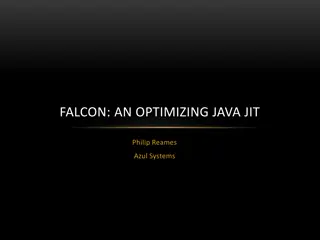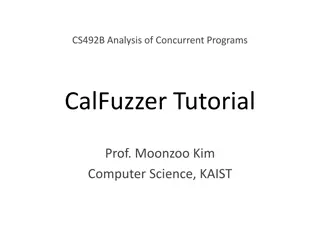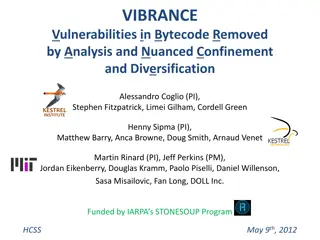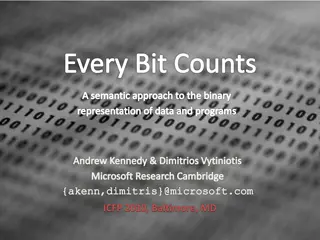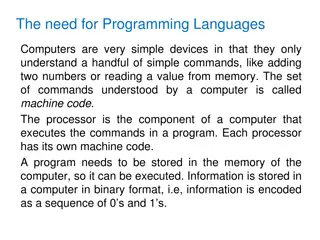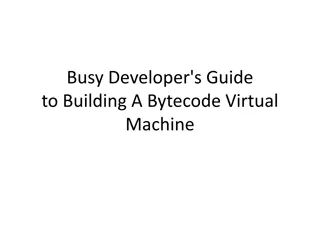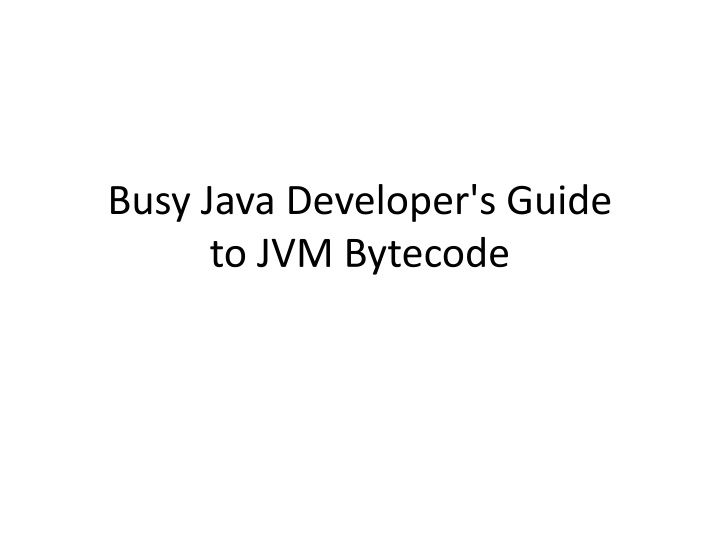
Understanding JVM Bytecode for Java Developers
Explore the world of JVM bytecode, gain insights into its significance, and discover how it enhances the execution of Java programs. Delve into JVM bytecode tools, instruction sets, and why using an intermediate language like JVM bytecode is beneficial for Java developers.
Download Presentation

Please find below an Image/Link to download the presentation.
The content on the website is provided AS IS for your information and personal use only. It may not be sold, licensed, or shared on other websites without obtaining consent from the author. If you encounter any issues during the download, it is possible that the publisher has removed the file from their server.
You are allowed to download the files provided on this website for personal or commercial use, subject to the condition that they are used lawfully. All files are the property of their respective owners.
The content on the website is provided AS IS for your information and personal use only. It may not be sold, licensed, or shared on other websites without obtaining consent from the author.
E N D
Presentation Transcript
Busy Java Developer's Guide to JVM Bytecode
Objectives Recognize & understand JVM bytecode Gain familiarity with bytecode tools Use bytecode to gain deeper insight into Java language features
From data to code JVM BYTECODE
JVM Bytecode JVM Bytecode Instruction Set Instruction set for execution of the Java Virtual Machine Conceptually similar to VB's P-code (or earlier precedents) Provides portable representation of executable code Can be interpreted or JIT compiled to native code Most JVMs JIT-compile frequently-executed
JVM Bytecode Why use an intermediate language like this? Class file format could contain CPU instructions In fact, could even contain multiple CPU's instructions This could provide WORA in a different fashion Avoid hit of JIT compilation at runtime, or interpretation Take advantage of CPU optimizations So why bother?
JVM Bytecode JVM provides "managed environment" Managed environments provide safety, robustness, security Harder to do with raw CPU instructions JVMIS can be optimized to particular CPU at runtime if desired But optimizations don't have to be decided at compile-time WORA
JVM Bytecode "So what? I know Java!" javap: Java developer's best friend disassemble any .class file, including Sun's disassembled code == JVMIS code Other languages starting to encroach on the JVM Groovy, JRuby, others starting to challenge Java's supremacy Bytecode-manipulation toolkits becoming more popular Helps delineate where Java language leaves
Example1 <</home/runner/work/Slides/Slides/Content/JVM/Bytecode/code/Hello.java NOT FOUND>> <</home/runner/work/Slides/Slides/Content/JVM/Bytecode/code/Hello.jbc NOT FOUND>>
What drives the look-and-feel of JVM bytecode JVMIS DESIGN PRINCIPLES
JVMIS Design Principles Smallest atom of code: class Dynamically loaded, linked at runtime Loaded via cooperating collection of ClassLoaders Verified at load-time
JVMIS Design Principles Stack-based, no registers All operations produce/consume stack elements Locals, incoming parameters, live on stack Stack slots are 32 bits wide (longs/doubles == 2 slots) May or may not use real stack if JITted
JVMIS Design Principles Names are fully-qualified class names "native" name format looks a bit different primitives have single-letter codes (I, J, V, ...) classes are "Ljava/lang/String;" format array typenames are "[type;", with one "[" per dimension "$" often used for synthesized class/field/method names
Organized loosely by function JVMIS OPCODES
JVM Instruction Set Stack manipulation dup, dup2: Duplicate top element of stack (pop, push, push) pop, pop2: Remove top element of stack Push constant value onto stack aconst_null bipush (-128 to 127), sipush (-32k to 32k) dconst_N, fconst_N, iconst_N, lconst_N, ldc X, ldc2_w X Local load: Push content of local var onto
JVM Instruction Set Arithmetic operations Data conversion: convert TOS to different type X-2-Y opcode naming convention d2f, d2i, d2l, f2d, f2i, f2l, ... tadd, trem, tsub, tmul, tdiv: + % - * / for all types t (d, f, i, l) iand, ior, ishl, ishr, ixor, ...: bitwise operations (int) dcmpg, dcmpl, fcmpg, fcmpl, lcmp: Comparison ops
JVM Instruction Set Branching, control flow nop: Do nothing goto: Branch always ifeq, ifge, ifgt, ifle, iflt, ifne, ifnonnull, ifnull: Branch if true jsr: Jump to location, push return location areturn, dreturn, freturn, ireturn, lreturn, return lookupswitch: switch/case implementation
JVM Instruction Set Object model instructions new, newarray, anewarray: Create object or array, push ref getfield, putfield: Get/Put top of stack (TOS) from/to field getstatic, putstatic: Get/Put from/to static field checkcast: Throw exception if top-of-stack is not of type instanceof: Push 1 if TOS is of type, else
Not necessarily opcodes JVMIS CODE STRUCTURE
JVM Instruction Set Exception Handling takes the form of an EH "table" alongside the method each line is a "from, to, target, type" tuple fromopcodeoffset toopcodeoffset goto target opcode offset when exception is thrown of type type type can be "any", usually indicating finally block
Test what you've learned! QUIZ TIME!
Question "How are inner classes implemented?" Think about it: JVM states that fundamental atom is a class Class private boundaries are enforced: no class gets access to another class's private parts So, without changing the JVM, how are inner classes handled?
Question "What's the cost of using assert?" Part of the goodness of C/C++ assert() was zero overhead in non-debug, production builds J2SE 1.4 introduced assert language keyword What's the cost of using it, even if turned off?
Question "How are generics implemented (in 1.5)?" We're being sold on the goodness of typesafe containers But is there a cost? How, without changing the JVM, are generics handled?
Question "Lambdas: How are they implemented (in 1.8)?" We're told they're not a breaking change to the JVM But in Java, everything needs to be in a class!
Question "Lambdas: How do they capture references (in 1.8)?" If a lambda captures a reference from enclosing scope... ... is that reference mutable? ... is the object on the other side of that reference mutable? ... does the lamdba capture a copy, or the actual reference?
Summary JVMIS is good to know offers insights into underlying platform offers access to power Java doesn't provide aids debugging and spelunking crucial to understanding compiler optimizations and/or costs way to justify all those college courses on assembly language just plain fun!
Resources Books Programming the Java Virtual Machine, by Engel Inside the Java2 Virtual Machine, by Venners JVM Specification, 2nd Ed, by Steele, et al
Credentials Who is this guy? Architect, Engineering Manager/Leader, "force multiplier" Principal -- Neward & Associates http://www.newardassociates.com Educative (http://educative.io) Author Performance Management for Engineering Managers Author Professional F# 2.0 (w/Erickson, et al; Wrox, 2010)


